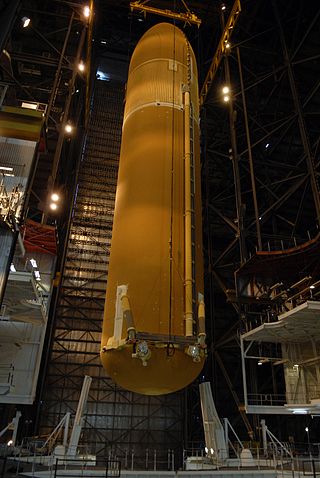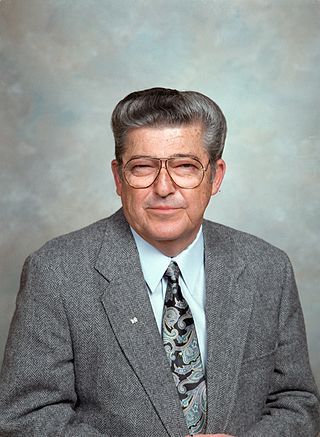Related Research Articles

Skylab was the first United States space station, launched by NASA, occupied for about 24 weeks between May 1973 and February 1974. It was operated by three separate three-astronaut crews: Skylab 2, Skylab 3, and Skylab 4. Major operations included an orbital workshop, a solar observatory, Earth observation, and hundreds of experiments.

The George C. Marshall Space Flight Center (MSFC), located in Redstone Arsenal, Alabama, is the U.S. government's civilian rocketry and spacecraft propulsion research center. As the largest NASA center, MSFC's first mission was developing the Saturn launch vehicles for the Apollo program. Marshall has been the lead center for the Space Shuttle main propulsion and external tank; payloads and related crew training; International Space Station (ISS) design and assembly; computers, networks, and information management; and the Space Launch System (SLS). Located on the Redstone Arsenal near Huntsville, MSFC is named in honor of General of the Army George C. Marshall.

STS-35 was the tenth flight of Space Shuttle Columbia, the 38th shuttle flight, and a mission devoted to astronomical observations with ASTRO-1, a Spacelab observatory consisting of four telescopes. The mission launched from Kennedy Space Center in Florida on December 2, 1990.

Nancy Jan Davis is a former American astronaut. A veteran of three space flights, Davis logged over 673 hours in space. She is now retired from NASA.

The Saturn IB was an American launch vehicle commissioned by the National Aeronautics and Space Administration (NASA) for the Apollo program. It uprated the Saturn I by replacing the S-IV second stage, with the S-IVB. The S-IB first stage also increased the S-I baseline's thrust from 1,500,000 pounds-force (6,700,000 N) to 1,600,000 pounds-force (7,100,000 N) and propellant load by 3.1%. This increased the Saturn I's low Earth orbit payload capability from 20,000 pounds (9,100 kg) to 46,000 pounds (21,000 kg), enough for early flight tests of a half-fueled Apollo command and service module (CSM) or a fully fueled Apollo Lunar Module (LM), before the larger Saturn V needed for lunar flight was ready.

The Space Shuttle Pathfinder is a Space Shuttle test simulator made of steel and wood. Constructed by NASA in 1977 as an unnamed facilities test article, it was purchased in the early 1980s by the America-Japan Society, Inc. which had it refurbished, named it, and placed it on display in the Great Space Shuttle Exhibition in Tokyo. The mockup was later returned to the United States and placed on permanent display at the U.S. Space & Rocket Center in Huntsville, Alabama, in May 1988.

James Shelton Voss is a retired United States Army colonel and NASA astronaut. During his time with NASA, Voss flew in space five times on board the Space Shuttle and International Space Station. He also served as deputy of Flight Operations for the Space Station Program Mission Integration and Operations Office. While participating in ISS Expedition 2, he and Susan Helms conducted an 8-hour and 56 minute spacewalk, the longest to date.

The Space Shuttle external tank (ET) was the component of the Space Shuttle launch vehicle that contained the liquid hydrogen fuel and liquid oxygen oxidizer. During lift-off and ascent it supplied the fuel and oxidizer under pressure to the three RS-25 main engines in the orbiter. The ET was jettisoned just over 10 seconds after main engine cut-off (MECO) and it re-entered the Earth's atmosphere. Unlike the Solid Rocket Boosters, external tanks were not re-used. They broke up before impact in the Indian Ocean, away from shipping lanes and were not recovered.

The U.S. Space & Rocket Center in Huntsville, Alabama is a museum operated by the government of Alabama, showcasing rockets, achievements, and artifacts of the U.S. space program. Sometimes billed as "Earth's largest space museum", astronaut Owen Garriott described the place as, "a great way to learn about space in a town that has embraced the space program from the very beginning."

The Michoud Assembly Facility (MAF) is an 832-acre manufacturing complex owned by NASA in New Orleans East, a section of New Orleans, Louisiana, in the United States. Organizationally it is part of NASA's Marshall Space Flight Center, and is currently a multi-tenant complex to allow commercial and government contractors, as well as government agencies, to use the site.

Alexander A. McCool Jr. was manager of the Space Shuttle Projects Office at the NASA George C. Marshall Space Flight Center in Huntsville, Alabama. During his career, McCool contributed to several space developments including the Apollo Program, Skylab and the Space Shuttle program.
Travis Shane Taylor is an American scientist, engineer, science fiction author, and the star of National Geographic Channel's Rocket City Rednecks which aired 2011–2013. Taylor has written numerous technical papers, science fiction novels, and two textbooks. He has appeared in television documentaries, including NGC's When Aliens Attack and starring as the lead investigator in History Channel's The Secret of Skinwalker Ranch.

James Robert Thompson Jr., known as J.R. Thompson, was the fifth director of the NASA Marshall Space Flight Center located in Huntsville, Alabama. He served as director from September 29, 1986, to July 6, 1989. Thompson also served as NASA's deputy director from July 6, 1989, to November 8, 1991.

Gene Porter Bridwell was the seventh director of the NASA Marshall Space Flight Center located in Huntsville, Alabama. He served as director from January 6, 1994 to February 3, 1996.

David Arnold King is an American engineer who was the tenth Director of the NASA Marshall Space Flight Center in Huntsville, Alabama.

Konrad Dannenberg was a German-American rocket pioneer and member of the German rocket team brought to the United States after World War II.

Richard G. Smith was director of NASA's John F. Kennedy Space Center from September 26, 1979 to August 2, 1986. Born in Durham, N.C., in 1929, Smith was educated in Alabama schools. After graduation from Decatur High School, he attended Florence State College and Auburn University. He received a bachelor's degree in electrical engineering from Auburn in 1951.

Alabama's first aeronautical event was on 10 March 1910 with the flight of a Wright biplane flown by Orville Wright in Montgomery, Alabama.

Heinrich Georg "Heinz" Struck was a German-American rocket scientist and member of the "von Braun rocket team." Struck worked in aerodynamics in both the private and federal sectors, particularly NASA, where he was recognized for his contributions to the Space Shuttle program.
George Landwehr von Pragenau was an Austrian-American engineer and rocket scientist. Brought to the U.S. by the Army for his work with transistors, he was heavily involved with the testing of the Saturn I and Saturn V rockets and the Space Shuttle. In 1985 he received NASA's Inventor of the Year Award for his work in stabilizing the Shuttle's fuel pumps.
References
- 1 2 "3 in Top-Level Posts at Space Agency Resign". Los Angeles Times . April 25, 1989. Retrieved March 7, 2021.
- 1 2 3 4 5 6 7 "Biographical Sketch" (PDF). nasa.gov. NASA. December 1986. Retrieved March 7, 2021.
- 1 2 Odom, James B. (August 26, 1993). "Interview with James B. Odom" (PDF) (Interview). Interviewed by Andrew Dunar and Stephen Waring. Huntsville, AL: NASA. Retrieved March 7, 2021.
- ↑ "Odom To Head NASA's Space Station Project". apnews.com. Associated Press. March 4, 1988. Retrieved March 7, 2021.
- ↑ Havemann, Judith (April 25, 1989). "2 TOP NASA OFFICIALS QUIT UNEXPECTEDLY". Washington Post. Retrieved March 7, 2021.
- 1 2 "Jim Odom honored with Chamber's Citizen of the Year award at Annual Meeting". dcc.org. Decatur-Morgan County Chamber of Commerce. April 9, 2019. Retrieved March 7, 2021.
- ↑ "James B. and June Peevy Odom Endowed Scholarship". auburn.academicworks.com. Auburn University. Retrieved March 7, 2021.